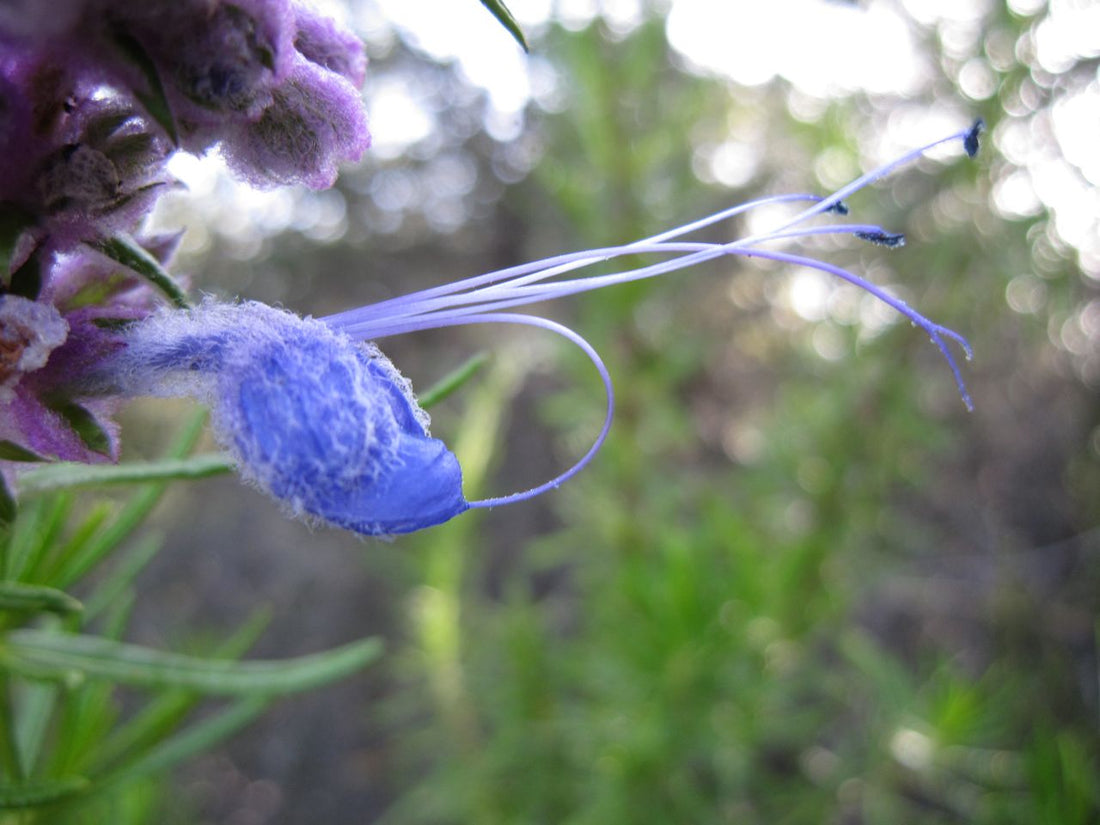
Therapeutics of Woolly Blue Curls: A Medicinal California Native Herb Profile
Share
Trichostema lanatum — Woolly Blue Curls
(American Wild Rosemary, Cobalt Curls)
Family: Lamiaceae (Mint Family)
Pharmaceutical name: Spica Trichostemae Lanati
Experience Woolly Blue Curls Firsthand
Explore our Woolly Blue Curls Essential Oil, sustainably wild grown and artisan-distilled at Refugio Gardens. This pure, genuine oil captures the sweet, resinous, mint-pine aroma of Trichostema lanatum, a plant long treasured in Native Californian and Spanish traditions for its euphoric, restorative qualities.
Quick-Start Use Guide
Topical (Essential Oil, Always Diluted)
- Apply 1 drop EO in 1 tsp carrier oil to abdomen for digestive comfort.
- Add 1–2 drops EO per 1 tsp carrier for massage blends, easing sore muscles.
Hydrosol (Traditional Internal Use)
2 Tbsp hydrosol in 1 L water, sipped during the day for gentle digestive or fever support (under practitioner guidance).
Inhalation
Diffuse 2–4 drops EO in water for mood uplift, respiratory clarity, and calm energy.
Aroma-Acupoint Application
Diluted EO or hydrosol may be applied to Ren 12, ST 25, ST 36 (digestive), DU 14, LI 4 (fever/head tension).
Safety: Essential oil is concentrated—always dilute, patch-test, and avoid eyes/mucosa. Not for pregnancy or infants. Hydrosol internal use is traditional; seek practitioner guidance.
Characteristics
- Plant: Very sweet, slightly pungent, aromatic, cooling
- Essential Oil: Sweet, green, slightly pungent, minty, pine-scented
- Hydrosol: Softer and greener than the oil; sweet herbal with piney freshness
Channel Tropism (TCM)
- Stomach
- Uterus
- Liver
Western Actions
Diaphoretic, euphoric (restorative-antidepressant), carminative, anti-inflammatory, antibacterial, digestive aid.
Chinese Medicinal Actions & Indications
- Regulates Stomach Qi: Gastric pain, indigestion
- Clears Wind-Heat & Releases the Exterior: Externally contracted fever without sweat
- Invigorates Blood & Promotes Labor: Retention of the placenta
Cautions & Contraindications
- Always patch test before topical use.
- Traditional internal use of hydrosol should be guided by a qualified practitioner.
- Not for use during pregnancy unless supervised by a professional.
Clinical Information
Patients have described Woolly Blue Curls as “romantic, enticing, uplifting, and aphrodisiac.” Traditional teas and hydrosols are used like chamomile for stomachache and fevers. Historically, Chumash healers employed infusions to expel the afterbirth, while Spanish Californians used decoctions for colds, flu, and bruises.
Traditional & Modern Preparations
- Tea (Infusion) — 1–2 g dried flowering tops steeped 5–10 minutes. Taken in ½–1 cup servings, up to 2–3× daily, for gentle digestive comfort and antioxidant support.
- Tincture (1:5, 40–60% alcohol) — Steep 2–4 weeks, strain. Use 1–2 mL in water, up to 2–3× daily. Alcohol extracts more resinous flavones for a stronger effect.
- Topical Wash or Compress — Use cooled tea or a few drops tincture diluted in water to quiet visible redness or irritation (patch-test first).
- Resin Poultice (folk) — Fresh crushed leaves applied as a cleansing poultice; modern version = warm water paste (patch-test advised).
Note: Woolly Blue Curls is potent and resinous; small amounts suffice. Avoid prolonged high-dose use; not for pregnancy. Seek professional guidance for internal use.
Modern Research & Chemistry Notes
Recent studies on Trichostema lanatum show that its resin-rich leaves contain not only aromatic oils but also unique plant polyphenols. These include special forms of apigenin, luteolin, and scutellarein—flavones with antioxidant and skin-calming potential. Laboratory extracts demonstrate selective antibacterial effects against Gram-positive bacteria (such as Staphylococcus aureus) and can lower TNF-α, a key inflammation signal. Together, these findings support traditional uses for soothing the body and point to modern applications for skin resilience and wellness. †
GC–MS analysis confirms the essential oil is strongly monoterpene-rich, dominated by α-thujene, with secondary contributions from pinene isomers, sabinene, β-phellandrene, and myrcene. This explains the oil’s sharp green-pine sparkle, soft herbal-floral heart, and lingering woody-balsamic veil. †
Perfume Note Breakdown
Top Notes (0–15 min)
- α-Thujene (~57%) → sharp peppery-green sparkle; dominant mint-pine brightness
- α/β-Pinene + Sabinene + β-Phellandrene → crisp conifer clarity, cool diffusion
- Limonene (~1%) → light citrus lift, delicate sheen
Middle (Heart) Notes (15 min–2 hrs)
- Myrcene (~7%) → herbal-balsamic depth; soft green-fruity body
- (E)-β-Ocimene (~3%) → airy floral-green nuance
Base Notes (Drydown, 2–6 hrs)
- Trace sesquiterpenes (β-caryophyllene, α-bisabolol) → soft woody-balsamic warmth, grounding persistence
Olfactory narrative: A vivid, α-thujene opening bursts with green-citrus-pine sparkle, settles into a sweet floral-herbal heart, and fades to a gentle woody-balsamic veil.
Ecological Role & Potency
Native to Southern California chaparral, Woolly Blue Curls thrives in rocky, sun-exposed soils. Its dense, velvet-like trichomes not only guard against drought but also secrete resins packed with fragrant oils and protective flavones—an adaptation that gives the plant resilience and aromatic strength. †
Major Known Plant Constituents
Essential Oil (GC–MS)
- α-Thujene (56.71%)
- Myrcene (6.76%)
- α-Pinene (6.29%)
- β-Phellandrene (6.13%)
- Sabinene (6.01%)
- β-Pinene (3.32%)
- (E)-β-Ocimene (2.81%)
- Limonene (1.07%)
- Trace: linalool, β-caryophyllene, γ-terpinene, α-bisabolol, 1,8-cineole
Resin Flavonoids (leaf/stem exudate)
- Apigenin-7,4′-dimethyl ether — antioxidant, helps calm visible redness
- Luteolin-7-methyl ether — studied for easing inflammatory skin responses
- Scutellarein-dimethyl ethers — linked to soothing and anti-redness actions
- Apigenin & Luteolin (parent forms) — classic flavones known for photoprotection and gentle calming effects
Internal Flavonoid Glycosides
- Water-soluble apigenin and luteolin glycosides act as reservoirs, gradually releasing active compounds for antioxidant defense and immune balance.
Woolly Blue Curls FAQ
What is Woolly Blue Curls essential oil?
A rare artisan-distilled oil from Trichostema lanatum, featuring a sweet, minty-pine aroma with euphoric, clarifying qualities.
How is the hydrosol used?
Traditionally sipped in water for digestive upset or used as a cooling, aromatic spray. Hydrosol offers a gentler expression than the essential oil.
Is it sustainably sourced?
Yes. Our plants are wild grown on private ranch land in Santa Barbara and distilled in small, ecologically mindful batches.
What research supports its benefits?
Studies show antibacterial and anti-inflammatory activity in extracts of Trichostema lanatum. GC–MS confirms a terpene-rich oil consistent with traditional digestive and fever uses.
Disclaimer
This article is provided for educational purposes only. Woolly Blue Curls has a long history of traditional use, but these statements have not been evaluated by the FDA. This content is not intended to diagnose, treat, cure, or prevent any disease. Always consult with a qualified health practitioner before using herbal products.
† For references and study details, see our References page.
